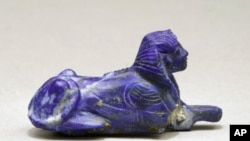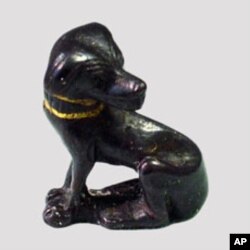Egypt and New York's Metropolitan Museum of Art, also known as the Met, have announced that objects in the museum that had been taken from the tomb of the famed pharaoh Tutankhamun would be sent back to Egypt.
|
Cairo Bureau Chief Elizabeth Arrott speaks with VOA Middle East Monitor Host Susan Yackee:
|
The museum agreed to recognize Egypt's right to 19 relics in its possession since early last century, accoording to a joint statement by the Met and the Supreme Council of Antiquities of Egypt.
The artifacts include a bronze figurine of a dog with a golden collar and a sphinx, part of a bracelet made of semi-precious lapis lazuli.
"Thanks to the generosity and ethical behavior of the Met, these 19 objects from the tomb of Tutankhamun can now be reunited with the other treasures of the boy king," Egyptian antiquities chief Zaki Hawass said.
"For many years the museum, and especially the Egyptian art department, has been a strong partner in our ongoing efforts to repatriate illegally exported antiquities," he said, adding that their research had helped Egypt recover a number of important objects.
Metropolitan Museum director Thomas Campbell said the Egyptian art department "produced detailed evidence leading us to conclude without doubt that 19 objects, which entered the Met's collection over the period of the 1920s to 1940s, originated in Tutankhamun's tomb."
"Because of precise legislation relating to that excavation, these objects were never meant to have left Egypt, and therefore should rightfully belong to the government of Egypt," he added.
Unlike other archaeological discoveries at the time, some of which the Egyptian government allowed excavators to keep, the treasures found in Tutankhamun's tomb were meant to stay in the country.
Fifteen of the 19 relics are "bits and samples," the statement said. The remaining four, including the dog figurine and the sphinx, are "of more significant art-historical interest."
Hawass said the objects will be on display in New York until June, when they will return to Egypt. They will be shown in the Tutankhamun galleries at Cairo's Egyptian Museum before moving with the rest of the Tut collection to the Grand Egyptian Museum at Giza, scheduled to open in 2012.
Tutankhamun is believed to have died more than 3,000 years ago when he was about 18 years old.
His tomb, which included a gold coffin and mask, was discovered in 1922 by English archaeologist Howard Carter.
The dog figurine, which stands less than three centimeters high, and the blue sphinx bracelet piece were inherited by Carter's niece as part of his estate.
Two other items, part of a handle and a beaded collar, were found in Carter's Luxor house, the entire contents of which were bequeathed to the Met.
The agreement with the museum is the latest victory for Hawass, who has aggressively campaigned for the return of some of the country's best known artifacts from abroad.
Hawass, who says he has brought back at least 5,000 relics since he became head of the antiquities council in 2003, earlier this year oversaw a conference of countries including Greece and China that also want looted treasures returned.
Last year, Hawass secured the return by the Louvre Museum in Paris of fresco fragments chipped from a tomb after he threatened to call off its excavations.
He has been campaigning for the return of the Rosetta Stone from the British Museum and the famous bust of Queen Nefertiti from Berlin's Neues Museum.
Some information in this story was provided by AP and AFP.











